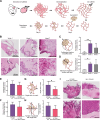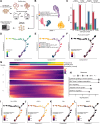Deciphering the role of FUS::DDIT3 expression and tumor microenvironment in myxoid liposarcoma development
- PMID: 38671504
- PMCID: PMC11046918
- DOI: 10.1186/s12967-024-05211-w
Deciphering the role of FUS::DDIT3 expression and tumor microenvironment in myxoid liposarcoma development
Abstract
Background: Myxoid liposarcoma (MLS) displays a distinctive tumor microenvironment and is characterized by the FUS::DDIT3 fusion oncogene, however, the precise functional contributions of these two elements remain enigmatic in tumor development.
Methods: To study the cell-free microenvironment in MLS, we developed an experimental model system based on decellularized patient-derived xenograft tumors. We characterized the cell-free scaffold using mass spectrometry. Subsequently, scaffolds were repopulated using sarcoma cells with or without FUS::DDIT3 expression that were analyzed with histology and RNA sequencing.
Results: Characterization of cell-free MLS scaffolds revealed intact structure and a large variation of protein types remaining after decellularization. We demonstrated an optimal culture time of 3 weeks and showed that FUS::DDIT3 expression decreased cell proliferation and scaffold invasiveness. The cell-free MLS microenvironment and FUS::DDIT3 expression both induced biological processes related to cell-to-cell and cell-to-extracellular matrix interactions, as well as chromatin remodeling, immune response, and metabolism. Data indicated that FUS::DDIT3 expression more than the microenvironment determined the pre-adipocytic phenotype that is typical for MLS.
Conclusions: Our experimental approach opens new means to study the tumor microenvironment in detail and our findings suggest that FUS::DDIT3-expressing tumor cells can create their own extracellular niche.
Keywords: Extracellular matrix; FET fusion oncogenes; FUS::DDIT3; Microenvironment; Myxoid liposarcoma; Scaffold.
© 2024. The Author(s).
Conflict of interest statement
AS and GL are co-inventors of the patient-derived scaffold approach that is patent approved (EP3535421/US11840732). AS is board member and declares stock ownership in Tulebovaasta, Iscaff Pharma and SiMSen Diagnostics. GL is board member and declares stock ownership in Iscaff Pharma and Sortina Pharma.
Figures




Similar articles
-
Nuclear expression of FLT1 and its ligand PGF in FUS-DDIT3 carrying myxoid liposarcomas suggests the existence of an intracrine signaling loop.BMC Cancer. 2010 Jun 1;10:249. doi: 10.1186/1471-2407-10-249. BMC Cancer. 2010. PMID: 20515481 Free PMC article.
-
The myxoid/round cell liposarcoma fusion oncogene FUS-DDIT3 and the normal DDIT3 induce a liposarcoma phenotype in transfected human fibrosarcoma cells.Am J Pathol. 2006 May;168(5):1642-53. doi: 10.2353/ajpath.2006.050872. Am J Pathol. 2006. PMID: 16651630 Free PMC article.
-
FUS::DDIT3 Fusion Protein in the Development of Myxoid Liposarcoma and Possible Implications for Therapy.Biomolecules. 2024 Oct 14;14(10):1297. doi: 10.3390/biom14101297. Biomolecules. 2024. PMID: 39456230 Free PMC article. Review.
-
Regulatory mechanisms, expression levels and proliferation effects of the FUS-DDIT3 fusion oncogene in liposarcoma.J Pathol. 2016 Apr;238(5):689-99. doi: 10.1002/path.4700. J Pathol. 2016. PMID: 26865464
-
Gene of the month: DDIT3.J Clin Pathol. 2024 Mar 20;77(4):211-216. doi: 10.1136/jcp-2023-208963. J Clin Pathol. 2024. PMID: 38053287 Review.
Cited by
-
An Incidental Finding of Gain of a Diminished Chromosome 12 Centromere in an Individual with Lymphocytosis: A Case Report and Clinical Implications in Cytogenetic Testing.Diagnostics (Basel). 2025 Mar 4;15(5):618. doi: 10.3390/diagnostics15050618. Diagnostics (Basel). 2025. PMID: 40075865 Free PMC article.
-
Breast cancer patient-derived scaffolds enhance the understanding of PD-L1 regulation and T cell cytotoxicity.Commun Biol. 2025 Apr 16;8(1):621. doi: 10.1038/s42003-025-08054-3. Commun Biol. 2025. PMID: 40240529 Free PMC article.
References
-
- WHO Classification of Tumours Editorial Board . Soft tissue and bone tumours. 5. Lyon: IARC Press; 2020.
-
- Riggi N, Cironi L, Suva ML, Stamenkovic I. Sarcomas: genetics, signalling, and cellular origins. Part 1: the fellowship of TET. J Pathol. 2007;213:4–20. - PubMed
-
- Åman P. Fusion oncogenes in tumor development. Semin Cancer Biol. 2005;15:236–243. - PubMed
Publication types
MeSH terms
Substances
Grants and funding
LinkOut - more resources
Full Text Sources
Molecular Biology Databases
Research Materials

